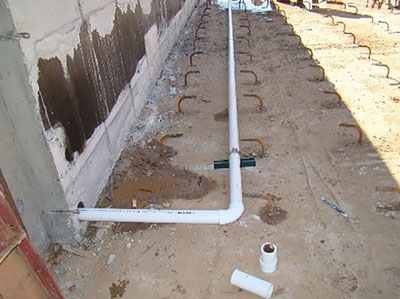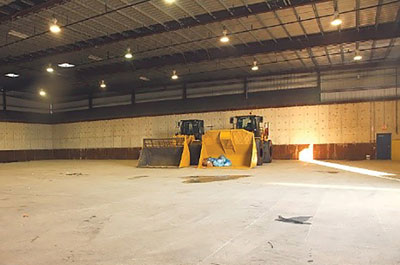The functionality of a solid waste facility is just as important as safety. This all begins in the design phase to help these facilities operate with both in mind.
By Evan Williams

We have all seen them. Solid waste facilities that are a little long in the tooth, in rough condition that appear ready to collapse, perhaps only being held up by the material packed between the columns with their loose siding fluttering in the breeze. While this is a common state of facilities in the industry, it is certainly not a predetermined result for these types of facilities. Through careful site and building planning, as well a dedicated operations and maintenance program, solid waste facilities can remain in good condition throughout their functional lifespan.
This article will examine several design approaches that can contribute to improved facility durability and minimize required maintenance. In addition, several approaches to operations will be discussed to extend the life of the facility and improve safety.
Designing for Durability
For transfer stations and material recovery facilities (MRFs) the goal is to put your money into the areas that are going to get the concentrated and continual wear and tear. Pay close attention to making these assemblies easy to repair to limit future down time and minimize the opportunities to get debris trapped in areas that are hard to clean.
Focus Area: Tipping Floor/Area
Push Walls
For the tipping area, your team will need to study your incoming material stream to determine when peak times are and the projected volumes during that period. When plotted against your transfer trailer loading times, you should be able to project the volume of material the building will need to hold as a part of your everyday operations. Using this information, you should plot out the size of the material pile you will have, as well as its height. This height will dictate the height of the push and scrape walls that will surround it. Heavy concrete walls are the material of choice for higher volume facilities. These walls should be designed with sufficient thickness and reinforcement to withstand the daily beating they will get from the material as well as the loader. Additional steel embedment, thicker wall assemblies and steel plate facings can all improve the performance of this assembly.

Floor Slabs
The floor is the most common area for accelerated wear in a solid waste facility from a combination of:
• Scraping from the loader bucket
• Material dragging across the surface
• Liquids in the material weakening the cement paste bond
• Concrete aggregate
These are all factors that make the floor slabs susceptible to premature failure. To minimize the cost and inconvenience of downtime for repairs, you should plan on making the slab more durable.
To do this, your design team should consider a high-performance concrete mix. In addition, concrete additives, structural fibers, toppings, etc. can all make marked improvements to the tipping slabs lifespan. Depending on your needs, the material the facility will process, your budget, the required lifespan of the facility and other similar factors will all contribute to what is the right solution for your situation.
Door Protection
It is very common to see the large overhead doors in solid waste facilities either not functioning or in very rough shape. This is often due to the doors themselves being too narrow and/or short. You and your design team should evaluate all the vehicle types your facility needs to accommodate. This includes what they look like in their tallest configuration (front loading truck hydraulic forks, end dump trailers and roll-offs are often around 25′ tall). In addition, making the doors slightly wider helps in facilities where the vehicles are backing in. Aside from right sizing the doors, you should plan on providing robust protection for the opening for the door jambs and tracks. This can be in the form of a large concrete-filled steel pipe bollard adjacent to the doors, to something as simple as a precast concrete bin block placed in the same location. The goal is to create a durable and highly visible assembly—ideally the vehicles see it rather than hit it. As an added precaution, you should mount very large signs indicating each doors height adjacent to each door that is visible to vehicles backing up.

Metal Building Durability
Most solid waste facilities use a structural steel primary frame with prefinished metal panels for siding and often the roof. While durable and cost-effective, these materials often do not hold up well to constant impacts and material being piled up against them. To that end, you should try to plan your facility where the incoming material is unloaded on concrete and piled up against concrete. Ideally, the metal building acts as a wrapper around the more durable concrete assemblies. Care should be taken where the concrete walls and metal building components connect to minimize the opportunity for loads to be transferred from the concrete to the metal, as well as avoiding areas for material to get trapped creating opportunities for vectors to set up residence. Another approach for durability is height. Make sure the building is much taller than your tallest piece of equipment. This will ensure there that are no vehicle strikes on the overhead structure. Since the metal building structure is low-cost, adding a few feet in height is often not very costly and certainly cheaper than replacing damaged structural members.
Focus Area: MRFs
Process Area
When designing MRFs, care should be taken with the design of the process area to make sure the building will hold up in the long-term. Here are several strategies to improve durability. Install all power conduits overhead. While it might be cheaper to bury them under the slab, if/when you will be in need of making future equipment changes, these may be in the way and costly to modify. When designing the floor, you might want to consider a more durable concrete mix under the pre-sort bunkers. This mix could be similar to the one used in the tipping area. The bottom 10′ of the perimeter of the building should be a more durable material—this can be a concrete curb with metal liner panel on top, concrete block or pre-cast concrete panels.

Bale Storage
The bale storage area should be designed in a logical fashion to encourage the forklift vehicles to stack the bales in the rights areas. The majority of these areas can be defined with floor striping. However, where bale stacks are adjacent to building columns or walls, guard rails or masonry or similar protective measures should be used.
Focus Area: Loading Pit
Design Approaches
The loading pit of a transfer station or residue load-out for MRFs is an area of concentrated wear. To minimize constant maintenance, this area should be designed with robust concrete assemblies. To minimize the mess of this operation, and the wear it can cause, you should design the pit with steel deflectors to ensure most of the material goes into the trailer. You will need to confirm what sort of yellow iron will be doing the loading (grapple or wheeled loader) as this will impact the design of the deflectors. Additionally, when you are designing the pit, make sure it is wide enough that your loader bucket can fit between the walls to make cleaning it easier.
Leachate Collection
It is a reality for most solid waste facilities that leachate management and collection is a part of their operation. This can be a real challenge due to the materials’ high level of suspended solids and large solid matter that can quickly plug up drain inlets, pipes and catch basins. Care should be taken when designing the leachate collection points to place these in areas not directly under vehicle traffic, material piles or doors. Placing the drains in these locations will allow loose material to be compressed into the grates by the vehicle tires. Instead, try to identify locations that are not in primary work areas to place the drains. In addition, oversize the drain lines to make cleaning easier, and consider inlet protections screens to keep out large matter from those assemblies.

Smart Operating Strategies to Improve Durability
How you run your facility and the way you maintain it works hand-in-hand with good design to keep it in good condition, which in the end translates into a safe and more efficient facility. The maintenance and operations of the facility should strive to be proactive in identifying typical areas for accelerated wear/damage to the facility and working to address or minimize the causes.
Focus Area: Tipping Floor
Loader Wear
There are several approaches to help minimize floor wear in these facilities. The wheel loader operators should be trained to not “slam” their bucket down on the floor as they work in the facility. Rather, it should sit slightly above the floor to minimize the scraping on the floor surface. This, along with making sure all four tires are constantly in contact with the floor and that they are not “riding” the bucket and the front wheels off the ground, will extend the life of the floor. Also, depending on your concrete design for the floor and the equipment you use, you could experiment with steel and rubber edge. A softer edge does not always lead to a longer floor life. In many instances, the soft edges dig out the cement paste between the harder aggregate and may put added stress on your loader.
Metal Building
A common operational issue for these facilities is piling material too high in one area causing it to spill off the top of the pile and damage the metal building’s sheeting from that impact. Staff should be trained to make piles larger at the base and to avoid any piles taller than the push walls. This situation often arises when the operator wants to keep the material pile as close to the loading pit as possible for speed/convenience. Perhaps this push wall in that area should be designed higher, but the operations should work within the parameters of the built facility as much as possible.

Metal Building Washing
These areas of the building are often very dusty. It is very common to see deep deposits of material on the horizontal surfaces of the metal building primary and secondary framing. This material can retain moisture, which can rust out the secondary framing at an accelerated rate. On a yearly basis you should evaluate this condition and if deposits are observed—consider power washing the interior of the metal building. Using a Hotsy or similar hot pressure washer should minimize leachate generation. An option during design and construction would be to use galvanized secondary members since this will significantly reduce rusting and extend the life of the building. Galvanizing will be a cost that should be worked into your maintenance budget and should be evaluated with your team and contractor.
There is not an objectively ‘best’ way to design a solid waste facility. Rather, the operations and design/construction teams should work to curate a collection of approaches and best practices to allow the facility design and operations to be tailored to the end user’s needs. Facility operations and needs changes over the course of its lifetime, your strategies should be flexible and be re-evaluated periodically to ensure they remain relevant, effective and ensure safety throughout the facility. | WA
Evan Williams is a Design Project Manager at Cambridge Companies (Griffith, IN), a design-build firm working with the waste industry for more than 20 years. During this time, more than 100 solid waste design-build projects have been completed including new build, repairs, upgrades and/or modifications at transfer stations, recycling centers/MRFs, hauling companies, landfill facilities, office buildings and more. Cambridge continually monitors the industry to determine any new needs, changes or improvements that will benefit their clients and improve their design-build solutions. Evan can be reached at (219) 972-1155, via e-mail at [email protected] or visit www.CambridgeCoInc.com.
